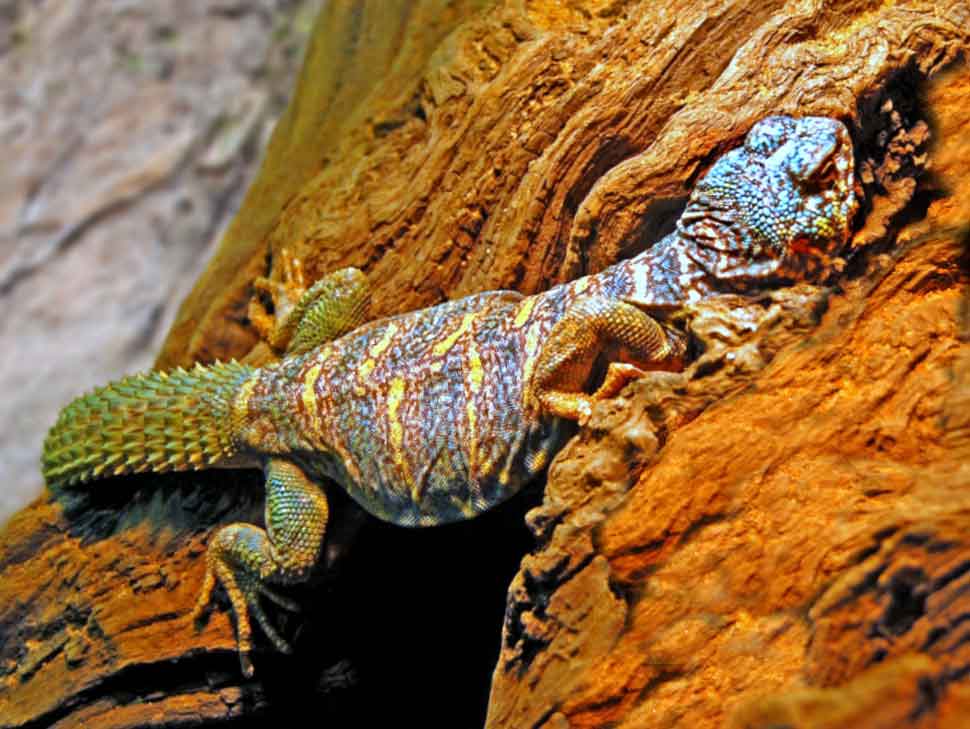
Content |
|---|
Distribution
Its natural range is the northeast of the Red Sea, from the Sinai Peninsula in the north to northern Yemen in the south.
This species does not occur in pure sandy deserts. They inhabit the cracks of rocks and caves of their biotopes or use burrows dug by themselves.
Characteristics
The Ornate mastigure reaches a maximum total length of 37 cm., although animals in captivity rarely exceed 32 cm..
Is a sexual dimorphism recognizable, males being much more colorful than females. But, are common to both sexes yellow dots or transverse bands that are visible from the neck on the back to the base of the tail. It also, females have a rather smooth cream coloration in the throat and belly.
Terrarium
The large enclosures are suitable for keeping this species of lizard, dry and spacious terrariums are suitable. I believe that 140 x 60 x 60 (long, width, alto) is the absolute minimum size for a single animal/pair. It's not always easy to find a harmonious partner, but most of the time the animals harmonize very well, and you can keep them as a couple throughout the year.
But, it should be possible to separate them at any time. If you don't want to breed, to the Uromastyx ornata can also be maintained individually, since they are actually solitary by nature. This avoids conflicts within the species.
The most colorful males are especially suitable for this, as they are usually more confident than females, but even a female does not feel alone, but it may happen that it forms unfertilized eggs without a male, which can lead to problems when putting them.
Construction of terrarium
The most suitable as substrate is a mixture of sand and mud suitable for excavation. To create additional space it makes sense to design the rear and side walls of the tank with “rock walls” polystyrene modeled, adhesive for tiles and epoxy resin. Other suitable furniture elements are secure stone structures with quarry slabs, the roots, cork tubes and various climbing branches.
It is also important to create several hiding places, but they must be controllable at all times without having to completely disassemble the terrarium. To avoid molting problems, a part of the terrarium may also have a slight moisture of the substrate, but not too much. You also have to spray from time to time. A bowl of water completes the installation.
The Temperatures should be 28-35°C in summer, with 12-14 hours of illumination, and up to 60°C in the sunning place. At night, the temperature can drop to room temperature. In winter, lighting is gradually reduced to 8 hours, and slowly increases again after a few 8-12 weeks. In winter, the temperature should be 20-28°C during the day and 18-20°C at night. A sunny spot should reach about 40-45°C for about 4 hours in this time.
Food
The Ornate mastigure they have an omnivorous diet, that is to say, eat both plant and animal foods.
Should not be fed animal feed too often, once or twice a week is enough. An exception must be made with pregnant females, which must be given a lot of animal protein. You can also feed them more treats. “Unhealthy”, such as rose beetles or wax moth larvae.
It can be given fresh vegetable food to adult animals about 3-4 times a week. Grain mixture and dried herbs/flowers can always be available to animals. But, in the case of particularly voracious specimens, you also have to ration this food to prevent them from getting fat.
All common types of insects available in specialized stores are suitable as animal feed, as well as self-caught prairie plankton. Grasshoppers, crickets and cockroaches are the most suitable.
All insects should be fed a high-quality diet 1-2 days before feeding, and dusted with a high-quality calcium vitamin mix about once a week. The fat larvae of the wax moth, zophobas and rose weevils should rarely serve as food as treats.
Young animals can be fed green food and insects daily. Subadults feed on green food on a daily basis, of insects on alternate days and a weekly fast.
The cereal mixture adapted to size is also always available for young animals and subadults.
Reproduction
Depending on geographical location and weather conditions, the mating season occurs in the spring months of March and April. Sexual maturity occurs among 3 and 5 years of age and probably a little earlier in females. During reproduction they are oviparous, the female usually buries some 15 – 20 eggs in the sand and after an incubation period of some 3 – 4 months the pups are born.
For sale Ornate mastigure
The price of a Ornate mastigure bred in captivity in the exotic animal market ranges from 350 – 400 EUR.
